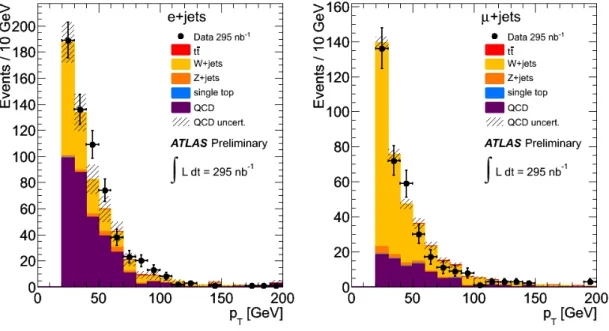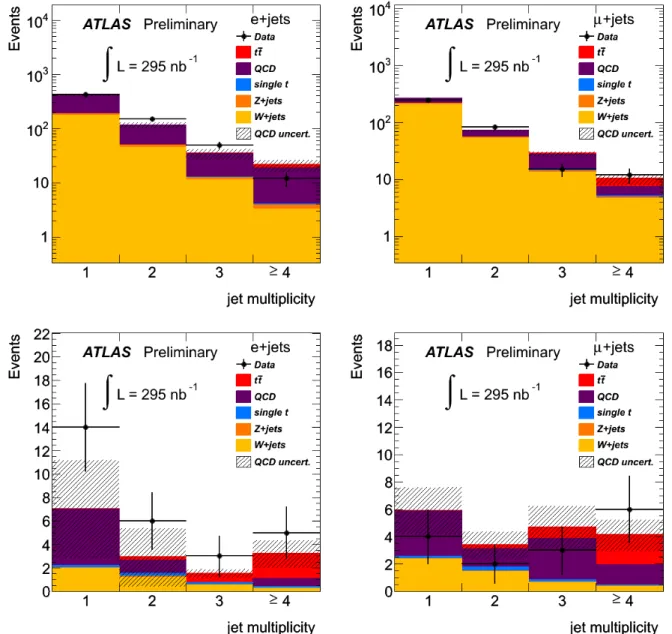A TLAS-CONF-2010-087 11 October 2010
ATLAS NOTE
ATLAS-CONF-2010-087
August 19, 2010
Background studies for top-pair production in lepton plus jets final states in √
s = 7 TeV ATLAS data
The ATLAS Collaboration
Abstract
The search for top quark pairs at the LHC requires the selection of events with leptons, high jet multiplicity, b-tagged jets and missing transverse energy, and the study of control samples with lower jet multiplicity to evaluate the backgrounds. A first study of the back- grounds in the lepton plus jets channel is presented using 295 nb
−1of ATLAS pp collision data taken at √
s = 7 TeV, including a data-driven determination of the contribution of QCD
multi-jet events.
1 Introduction
The observation of top quark pair production is one of the key milestones for the early LHC physics program. The ATLAS collaboration has already presented first top pair candidate events in both lepton plus jets and dilepton plus jets channels, using an event selection designed for an early measurement of the t¯ t production cross-section [1]. However, the lepton plus jets channel in particular su ff ers from significant background contributions from other Standard Model processes, and the understanding of these backgrounds using data is an essential step in measuring the rate of top pair production.
The main backgrounds in the lepton plus jets channel are the production of W bosons in association with multiple additional jets, and QCD multi-jet events where one jet is misidentified as a lepton (electron or muon). As b-jet tagging is used in the selection, the fraction of these processes where b b ¯ pairs are produced is particularly important. None of these backgrounds can be estimated reliably from Monte Carlo simulation; all require studies using data. The W + jets background at high jet multiplicity can be constrained by looking at lower jet multiplicity bins, with and without b-tagging. The QCD multi-jet background can be studied using background-enhanced control samples and loosened lepton selections, and predictions for the contribution in the signal region can then be derived.
This note presents distributions for the lepton plus jets top pair event selection, modified to relax the requirements on the number of jets and number of b-tagged jets. The distributions are compared to expectations from Monte Carlo simulation for t¯ t, single top and W / Z + jets, together with QCD multi-jet contributions predicted from data by the so-called ‘matrix method’. After introducing the data selection and corresponding samples of Monte Carlo simulated data, the object and event selections are described, and the selected event distributions are presented.
2 Data sample
The ATLAS detector [2] covers nearly the entire solid angle around the collision point with layers of tracking detectors, calorimeters and muon chambers.
1All these detectors play important roles in the reconstruction of t¯ t events, and only data where all were fully operational is used. Applying these re- quirements to √
s = 7 TeV pp collision data taken in stable beam conditions and recorded up until 19th July 2010 results in a data sample of about 295 nb
−1. This luminosity estimate has an uncertainty of 11%
[3].
3 Simulated event samples
For the generation of t¯ t signal and single top events, MC@NLO [4] v3.41 was used, with PDF set CTEQ66 [5], assuming a top mass of 172.5 GeV and normalizing the t¯ t cross-section to the prediction of [6], which is consistent with calculations performed at next-to-leading order. For single top the s, t and Wt channels are included, normalizing to the MC@NLO cross-section and using the ‘diagram removal scheme’ [7] for Wt to remove overlaps with the t¯ t final state.
For the generation of W +(b b)+jets and ¯ γ
∗/Z +(b b)+jets (Drell-Yan), A ¯ v2.13 was used, invok- ing the MLM matching scheme [8] with matching parameters RCLUS = 0.7 and ETCLUS = 20, and using parton density function set CTEQ6L1 [9]. For the γ
∗/Z +jets the phase space has been restricted to m(l
+l
−) > 40 GeV. The W / Z +jets samples were normalized with a K-factor (ratio of next-to-leading to leading-order cross-sections) of 1.22 [10]. All events were hadronized with H [11], using Jimmy [12] for the underlying event model.
1
In the right-handed ATLAS coordinate system, the pseudorapidity
ηis defined as
η=−ln(tan(θ/2)), where the polar angle
θis measured with respect to the LHC beamline. The azimuthal angle
φis measured with respect to the
x-axis, which pointstowards the centre of the LHC ring. The z-axis is parallel to the anti-clockwise beam.
Subsequent detector and trigger simulation, followed by offline reconstruction, has been performed with standard ATLAS software making use of GEANT4 [13]. The e ff ect of pileup, i.e. additional proton-proton interactions in the same beam crossing, was not simulated, but is expected to be small for the studies presented here.
4 Object selection
The reconstruction of t¯ t events makes use of reconstructed electrons, muons and jets, and the overall momentum balance in the transverse plane. The following criteria, identical to those employed in [1], are used to define the selected objects in the events:
• Electrons: Electron candidates are required to pass the medium electron selection as defined in [14], with p
T> 20 GeV and |η
cluster| < 2.47, excluding the calorimeter transition region at 1.37 <
|η
cluster| < 1.52, where η
clusteris the pseudo-rapidity of the calorimeter energy cluster associated with the candidate. The track must have an associated hit in the innermost pixel layer in order to remove photon conversions, except where the track passes through one of the 2 % of modules known to be dead. Furthermore, the additional energy deposition in the calorimeter within a cone of radius ∆ R = 0.2 must be less than 4 GeV + 0.023 · p
`T, where ∆ R = p
∆ η
2+ ∆ φ
2and p
`Tis the transverse momentum of the electron. The last requirement ensures electrons are isolated, reducing the rate of jets misidentified as electrons, and suppressing the selection of electrons from heavy flavour decays inside jets.
• Muons: Muons are reconstructed by combining tracks from the inner detector with tracks in the muon spectrometer using the algorithm defined as ‘chain 2’ in [15], requiring p
T> 20 GeV and
|η| < 2.5. To ensure isolation, the energy deposition in the calorimeter and the sum of track transverse momenta measured in cones of radius of ∆ R = 0.3 around the muon track are each required to be less than 4 GeV. Additionally, muons are required to have a distance ∆ R greater than 0.4 from any jet with p
T> 20 GeV, further suppressing muons from heavy flavour decays inside jets.
• Jets: Jets are reconstructed with the anti-k
talgorithm [16] with parameter R = 0.4, by combining topological clusters in the calorimeters [17]. The clusters are reconstructed at the electromagnetic (EM) energy scale, assuming the energy deposits are due to electrons or photons. The jets are then calibrated to the hadronic energy scale, using p
Tand η dependent correction factors obtained from simulation [18]. If a jet is the closest jet to an electron candidate and the corresponding distance
∆ R is less than 0.2, the jet is removed from consideration in order to avoid double-counting of electrons as jets. Jets are considered b-tagged if the secondary vertex-based tagger SV0 returns a value above a threshold that is defined by a 50% tagging e ffi ciency, obtained from studies of simulated t¯ t events [19].
• Missing transverse energy: The missing transverse energy E
missTis constructed from the vector sum of all calorimeter cells, resolved into the transverse plane. Cells not associated to a jet or electron are included at the EM scale. Cells associated with jets are taken at the corrected energy scale that was used for jets, while the contribution from cells associated with electrons are substituted by the calibrated transverse energy of the electron. Finally, the contribution from muons passing the ‘chain 2’ requirements are included, also removing the contribution of any calorimeter cell associated to the muon.
For the implementation of the matrix method to estimate QCD background, looser lepton selections
are required. For electrons, a loose selection is defined by removing the requirement that the electron
have a hit in the innermost pixel layer. For muons, the loose selection removes the < 4 GeV requirements on isolation energy in cones of ∆ R = 0.3 in both tracking and calorimetry.
5 Event selections
The t¯ t candidate event selection for the lepton plus jets channel starts by requiring exactly one o ffl ine- reconstructed electron or muon with p
T> 20 GeV and satisfying the object requirements given in Sec- tion 4 above. For the electron channel, the reconstructed electron must match a level-one electromagnetic trigger object with a 10 GeV p
Tthreshold within ∆ R < 0.15. For the muon channel, the 10 GeV-threshold level-one trigger is required to have fired, but no matching requirement is imposed.
2Events must have a reconstructed primary vertex with at least 5 tracks, and are discarded if any jet with p
T> 10 GeV at the EM scale fails jet quality cuts designed to reject jets arising from out-of-time activity or calorimeter noise [20]. These quality cuts remove a negligible fraction of simulated events.
For the t¯ t candidate selection, at least four jets with p
T> 20 GeV and |η| < 2.5 are required, at least one of which must be b-tagged. For the control samples studied in this note, the event selection is modified to accept events with one or more jets, with and without b-tagging requirements. Finally, the missing transverse energy must satisfy E
Tmiss> 20 GeV in both electron and muon channels.
6 Estimate of QCD multi-jet background
The QCD multi-jet background is determined from the data using the matrix method, which works by defining two event samples: the ‘tight’ sample passing all event selection cuts defined above, and a ‘loose’ sample where the lepton identification cuts are relaxed as discussed in Section 4 above. The numbers of events in the tight and loose samples (N
tightand N
loose) can be broken down into contributions from ‘real’ leptons produced in W and Z decays, and ‘fake’ leptons from all other sources in QCD multi- jet events (leptons produced from heavy flavour decays inside jets, photon conversions, misidentified hadrons, etc.):
N
loose= N
realloose+ N
fakeloose,
N
tight=
realN
realloose+
fakeN
fakeloose, (1)
where
real= N
realtight/N
reallooseand
fake= N
faketight/N
fakelooseare the fractions of loose real and fake leptons that also satisfy the tight lepton identification criteria. These ratios are estimated using control samples enriched in real and fake leptons respectively. With this small initial data sample,
realis taken from Monte Carlo simulated Z → `` events, and
fakeis taken from a real data control sample enriched in QCD multi-jet events, selected by requiring at least one jet with p
T> 20 GeV and E
Tmiss< 10 GeV.
Using these estimates, the equation (1), which can also be written in matrix form, can be solved to give an estimate of N
faketight, the number of fake leptons from QCD multi-jet events in the tight sample, together with the associated statistical error dependent on N
looseand N
tight. Since the
fakecontrol sample is not pure, but has a small residual contamination from W and Z events, this procedure has to be iterated and typically converges after two iterations. In practice, the procedure is performed in bins to yield estimates as a function of jet multiplicity or kinematic variables, both before and after applying the b-tagging requirement.
Several other methods of measuring the QCD multi-jet background are under development, making use of alternative lepton selections and control samples, various fitting techniques, and complementary information such as the impact parameters of lepton candidate tracks with respect to the primary vertex.
At this preliminary stage, the di ff erent methods agree to within about 30 % in regions where enough
2


